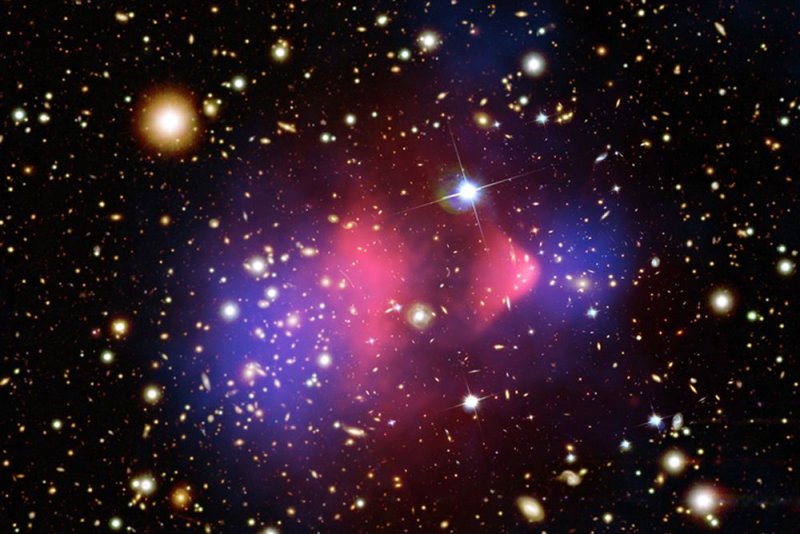Scientists working with NASA's Chandra X-Ray Observatory announced that they have found direct evidence that dark matter exists in the Universe on August 21, 2006. Dark matter is one of the holy grails of astronomy since little is known about it though theories say it accounts for 90 per cent of the matter of the Universe. In this image, a purple haze shows dark matter flanking the "Bullet Cluster." Image credit includes: X-ray: NASA/CXC/M.Markevitch et al. Optical: NASA/STScI; Magellan/U.Arizona/D.Clowe et al. Lensing Map: NASA/STScI; ESO WFI; Magellan/U.Arizona/D.Clowe. (UPI Photo/NASA) |
License Photo
CAMBRIDGE, Mass., June 25 (UPI) -- Dark matter is everywhere. According to astronomers, it makes up some 80 percent of all matter in the universe. But since it doesn't absorb or emit light, scientists have never seen dark matter. They don't even know what it is exactly.
But a recent spike of x-rays originating from 70 different galaxy clusters has some scientists excited at the off chance it's a signal from decaying dark matter.
"We know that the dark matter explanation is a long shot, but the payoff would be huge if we're right," said Esra Bulbul, who led the research into the strange spike in x-ray emissions, recently published in The Astrophysical Journal.
"We're going to keep testing this interpretation and see where it takes us," added Bulbul -- an astronomer at the Harvard-Smithsonian Center for Astrophysics in Cambridge, Massachusetts.
Because it's never been seen or observed, what dark matter is composed of exactly is highly theoretical. So far, scientists best guess is that dark matter is made up of a sterile neutrinos -- a type of neutral, weakly interacting elementary subatomic particle.
The mysterious x-ray spike was picked up by the highly sensitive NASA's Chandra X-ray Observatory and the European Space Agency's XMM-Newton satellite. But scientists say they need even more precise observations of the x-ray emissions if they're going to arrive at more definitive conclusions.
"We have a lot of work to do before we can claim, with any confidence, that we've found sterile neutrinos," admitted study co-author Maxim Markevitch, a researcher at NASA's Goddard Space Flight Center in Greenbelt, Maryland. "But just the possibility of finding them has us very excited."
"Our next step is to combine data from Chandra and JAXA's [the Japanese Aerospace Exploration Agency's] Suzaku mission for a large number of galaxy clusters to see if we find the same X-ray signal," explained co-author Adam Foster, one of Bulbul's colleagues in Cambridge.
Though normal matter could be responsible for the spike, scientists say the pattern doesn't mesh well with how hot gases are understood to give off x-rays.















